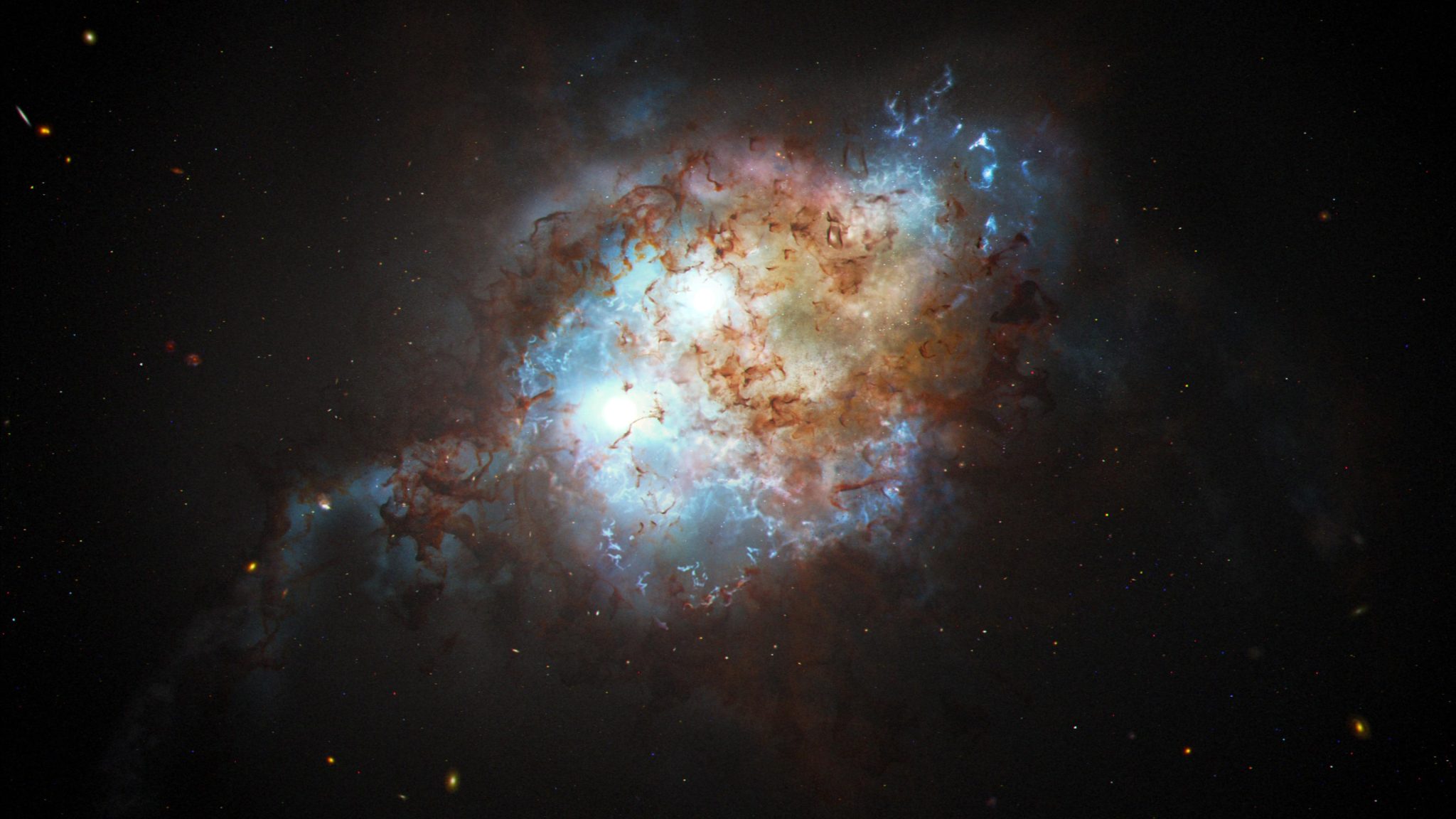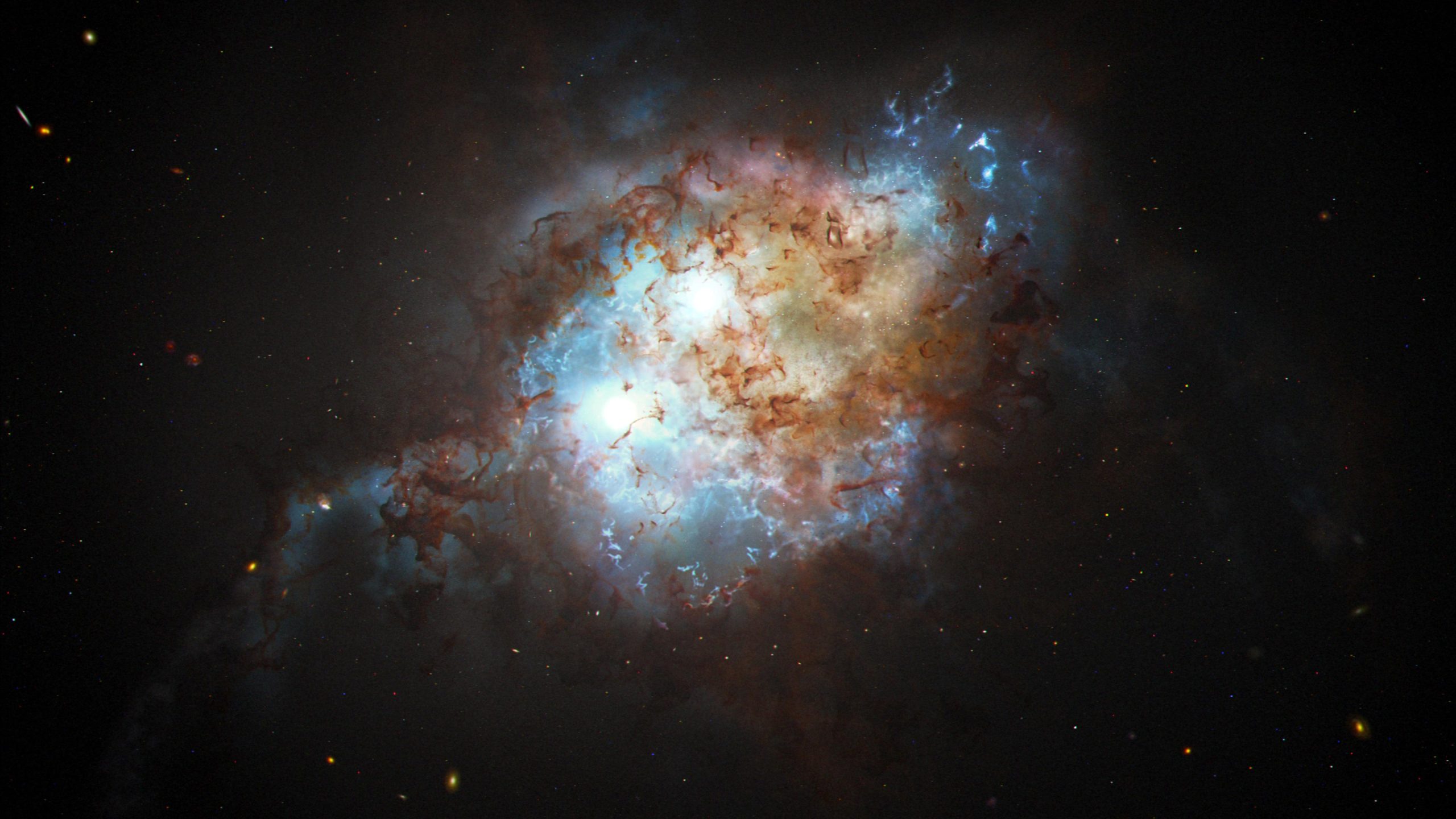
يُظهر مفهوم هذا الفنان الوهج المذهل لاثنين من النجوم الزائفة المقيمين في مراكز مجرتين في عملية اندماج فوضوية. يشعل سحب الجاذبية بين مجرتين العاصفة النارية لولادة النجوم. الكوازارات هي منارات رائعة لضوء شديد من مراكز المجرات البعيدة. يتم تشغيلها بواسطة الثقوب السوداء الهائلة التي تتغذى على المواد المتساقطة. يطلق هذا الهيجان المغذي العنان لتيار من الإشعاع يمكن أن يفوق الضوء الجماعي لمليارات النجوم في المجرة المضيفة. على مدى بضعة مليارات من السنين ، سوف تندمج الثقوب السوداء ومجراتها لتشكل زوجًا من النجوم الزائفة ، وهو ثقب أسود أكبر. الائتمان: ناسا ووكالة الفضاء الأوروبية وجوزيف أولمستيد (STScI)
يشعل زوج من المجرات المندمجة ثقوبًا سوداء في مسار تصادمي
النجوم الزائفة هي من بين ألمع الألعاب النارية في الكون. تنتشر في السماء ، وتحترق بثراء أكثر من 100 مليار نجم. ومثلما يمتد الرابع من يوليو اللامع عبر السماء ، فإنهم يتألقون لفترات زمنية قصيرة نسبيًا – على المقاييس الزمنية الكونية. هذا لأنها مدعومة من الثقوب السوداء الهائلة المضطربة التي تبتلع كميات وفيرة من الغاز والغبار التي ترتفع درجة حرارتها إلى درجات حرارة عالية. لكن بوفيه طعام الكوازار يستمر لفترة طويلة فقط.
مكنت هذه الخاصية السريعة للكوازارات علماء الفلك من اكتشاف اصطدام اثنين من النجوم الزائفة مع بعضهما البعض. هم جزء لا يتجزأ من زوج من المجرات التي اصطدمت قبل 10 مليارات سنة. مثل هذه التوائم النشطة نادرة في الكون البعيد. تقدم النتائج أدلة على مدى عدم استقرار الكون منذ فترة طويلة ، عندما تصطدم المجرات بشكل متكرر وابتلعت الثقوب السوداء في حطام وجتسام من المواجهات القريبة.
نظرًا لتوهج الكوازارين بمعدلات مختلفة مع تلاشي وقودهما وتلاشيهما ، فقد تم تحديدهما على أنهما عملية غير عادية في الفضاء. قام تلسكوب هابل بتكبير الصورة وحل الزوجين والمجرات المضيفة بوضوح.

صورة تلسكوب هابل الفضائي لزوج من الكوازارات عندما كان عمر الكون 3 مليارات سنة فقط. إنها مطمورة في زوج من المجرات المتصادمة. الكوازارات مفصولة بحجم أقل من مجرة. تعمل الكوازارات بواسطة الثقوب السوداء الهائلة والمضطربة التي تنفجر نوافير الطاقة الشرسة أثناء اندماجها في الغاز والغبار وأي شيء آخر في قبضتها الجاذبية. تندمج الثقوب السوداء في النهاية. الائتمان: ناسا ، وكالة الفضاء الأوروبية ، يو تشينغ تشين (UIUC) ، هسيانغ-تشيه هوانغ (IAS) ، ناديا زاكامسكا (JHU) ، يو شين (UIUC)
اكتشف تلسكوب هابل الفضائي بشكل غير متوقع كوازار مزدوج في الكون البعيد
كان الكون المبكر مكانًا محمومًا حيث تصطدم المجرات في كثير من الأحيان وتندمج معًا. استخدام[{” attribute=””>NASA’s Hubble Space Telescope and other space and ground-based observatories, astronomers investigating these developments have made an unexpected and rare discovery: a pair of gravitationally bound quasars, both blazing away inside two merging galaxies. They existed when the universe was just 3 billion years old.
Quasars are bright objects powered by voracious, supermassive black holes blasting out ferocious fountains of energy as they engorge themselves on gas, dust, and anything else within their gravitational grasp.
“We don’t see a lot of double quasars at this early time in the universe. And that’s why this discovery is so exciting,” said graduate student Yu-Ching Chen of the University of Illinois at Urbana-Champaign, lead author of this study.
Finding close binary quasars is a relatively new area of research that has just developed in the past 10 to 15 years. Today’s powerful new observatories have allowed astronomers to identify instances where two quasars are active at the same time and are close enough that they will eventually merge.
There is increasing evidence that large galaxies are built up through mergers. Smaller systems come together to form bigger systems and ever larger structures. During that process there should be pairs of supermassive black holes formed within the merging galaxies. “Knowing about the progenitor population of black holes will eventually tell us about the emergence of supermassive black holes in the early universe, and how frequent those mergers could be,” said Chen.

This compass image shows a Hubble Space Telescope photograph of a pair of quasars that existed when the universe was just 3 billion years old. They are embedded inside a pair of colliding galaxies. The quasars are separated by less than the size of a single galaxy. Quasars are powered by voracious, supermassive black holes blasting out ferocious fountains of energy as they engorge themselves on gas, dust, and anything else within their gravitational grasp. The black holes will eventually merge. Credit: NASA, ESA, Yu-Ching Chen (UIUC), Hsiang-Chih Hwang (IAS), Nadia Zakamska (JHU), Yue Shen (UIUC)
We’re starting to unveil this tip of the iceberg of the early binary quasar population,” said Xin Liu of the University of Illinois at Urbana-Champaign. “This is the uniqueness of this study. It is actually telling us that this population exists, and now we have a method to identify double quasars that are separated by less than the size of a single galaxy.”
This was a needle-in-haystack search that required the combined power of NASA’s Hubble Space Telescope and the W.M. Keck Observatories in Hawaii. Multi-wavelength observations from the International Gemini Observatory in Hawaii, NSF’s Karl G. Jansky Very Large Array in New Mexico, and NASA’s Chandra X-ray Observatory also contributed to understanding the dynamic duo. And, ESA (European Space Agency)’s Gaia space observatory helped identify this double quasar in the first place.
“Hubble’s sensitivity and resolution provided pictures that allow us to rule out other possibilities for what we are seeing,” said Chen. Hubble shows, unequivocally, that this is indeed a genuine pair of supermassive black holes, rather than two images of the same quasar created by a foreground gravitational lens. And, Hubble shows a tidal feature from the merging of two galaxies, where gravity distorts the shape of the galaxies forming two tails of stars.
However, Hubble’s sharp resolution alone isn’t good enough to go looking for these dual light beacons. The researchers enlisted Gaia, which launched in 2013, to pinpoint potential double-quasar candidates. Gaia measures the positions, distances, and motions of nearby celestial objects very precisely. But in a novel technique, it can be used to explore the distant universe. Gaia’s huge database can be used to search for quasars that mimic the apparent motion of nearby stars. The quasars appear as single objects in the Gaia data because they are so close together. However, Gaia can pick up a subtle, unexpected “jiggle” that mimics an apparent change in position of some of the quasars it observes.
In reality, the quasars aren’t moving through space in any measurable way. Instead, their jiggle could be evidence of random fluctuations of light as each member of the quasar pair varies in brightness on timescales of days to months, depending on their black hole’s feeding schedule. This alternating brightness between the quasar pair is similar to seeing a railroad crossing signal from a distance. As the lights on both sides of the stationary signal alternately flash, the sign gives the illusion of “jiggling.”
Another challenge is that because gravity warps space like a funhouse mirror, a foreground galaxy could split the image of a distant quasar into two, creating the illusion it was really a binary pair. The Keck telescope was used to make sure there was no lensing galaxy in between us and the suspected double quasar.
Because Hubble peers into the distant past, this double quasar no longer exists. Over the intervening 10 billion years, their host galaxies have likely settled into a giant elliptical galaxy, like the ones seen in the local universe today. And, the quasars have merged to become a gargantuan, supermassive black hole at its center. The nearby giant elliptical galaxy, M87, has a monstrous black hole weighing 6.5 billion times the mass of our Sun. Perhaps this black hole was grown from one or more galaxy mergers over the past billions of years.
The upcoming NASA Nancy Grace Roman Space Telescope, having the same visual acuity as Hubble, is ideal for binary quasar hunting. Hubble has been used to painstakingly take data for individual targets. But Roman’s very wide-angle infrared view of the universe is 200 times larger than Hubble’s. “A lot of quasars out there could be binary systems. The Roman telescope can do huge improvements in this research area,” said Liu.
The results will be published in the April 5 journal Nature.
Reference: “A close quasar pair in a disk–disk galaxy merger at z = 2.17” by Yu-Ching Chen, Xin Liu, Adi Foord, Yue Shen, Masamune Oguri, Nianyi Chen, Tiziana Di Matteo, Miguel Holgado, Hsiang-Chih Hwang and Nadia Zakamska, 5 April 2023, Nature.
DOI: 10.1038/s41586-023-05766-6
The Hubble Space Telescope is a project of international cooperation between NASA and ESA. NASA’s Goddard Space Flight Center in Greenbelt, Maryland, manages the telescope. The Space Telescope Science Institute (STScI) in Baltimore, Maryland, conducts Hubble and Webb science operations. STScI is operated for NASA by the Association of Universities for Research in Astronomy, in Washington, D.C.

“متعصب للموسيقى. مستكشف متواضع جدا. محلل. متعصب للسفر. مدرس تلفزيوني متطرف. لاعب.”

